Organisational Behaviour Report: Tesco's Team Dynamics and Motivation
VerifiedAdded on 2021/02/20
|13
|3998
|76
Report
AI Summary
This report analyzes the organisational behaviour within Tesco, a multinational retailer. It examines how organisational culture, power dynamics, and politics influence team and individual performance, referencing Handy's typology to assess Tesco's cultural environment. The report assesses the role of process and content theories in achieving organisational goals, including Maslow's Hierarchy of Needs and Vroom's Expectancy Theory, highlighting their application within Tesco's motivational strategies. Furthermore, the report discusses the elements that contribute to effective and ineffective teams, and applies various organisational behaviour philosophies and concepts in the context of Tesco's operations, offering insights into leadership, motivation, and team dynamics. The analysis emphasizes how reward power can motivate employees and contribute to overall organisational success. The assignment covers topics from task culture to the application of different motivational models, providing a comprehensive overview of organisational behaviour principles within a corporate setting.
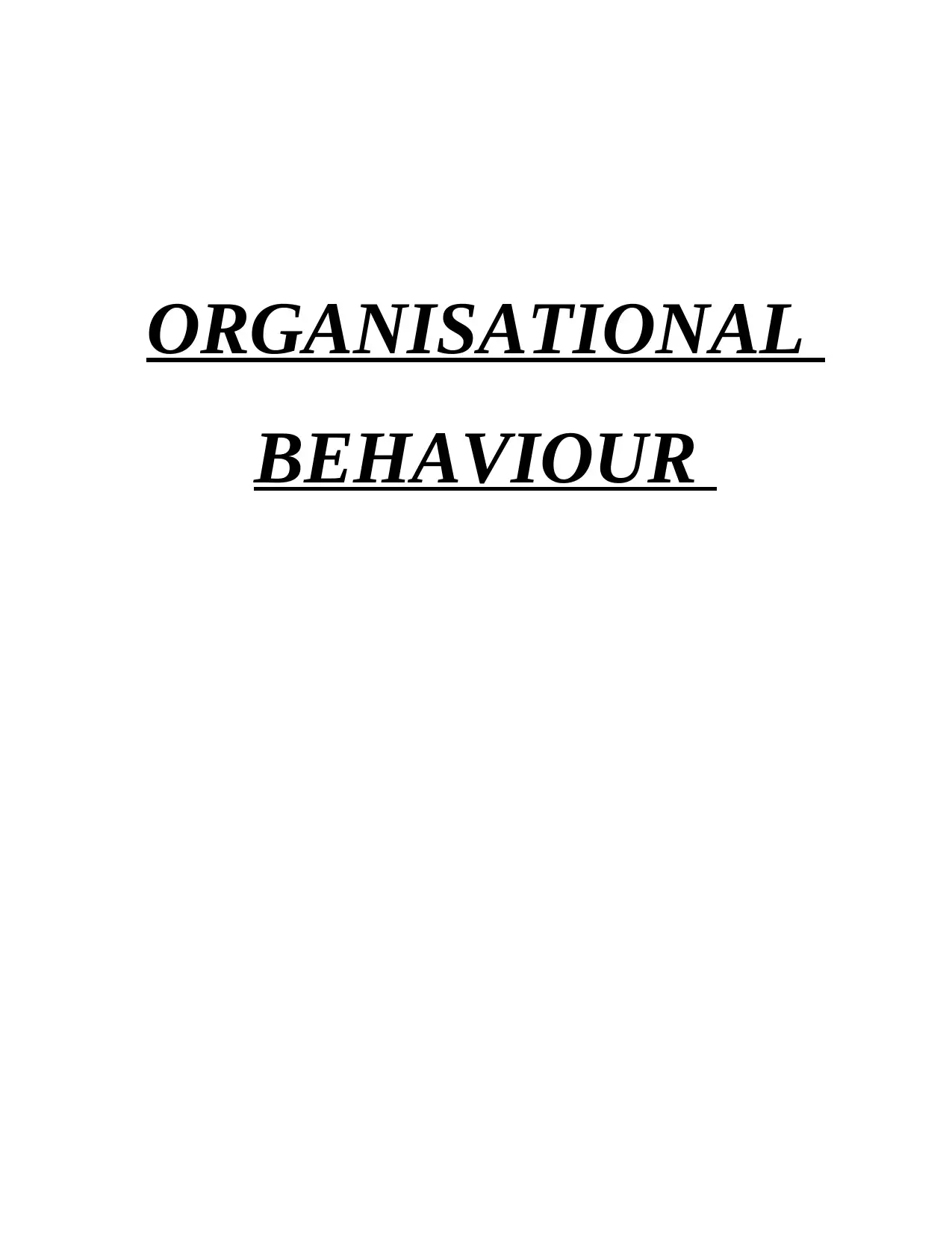
ORGANISATIONAL
BEHAVIOUR
BEHAVIOUR
Paraphrase This Document
Need a fresh take? Get an instant paraphrase of this document with our AI Paraphraser
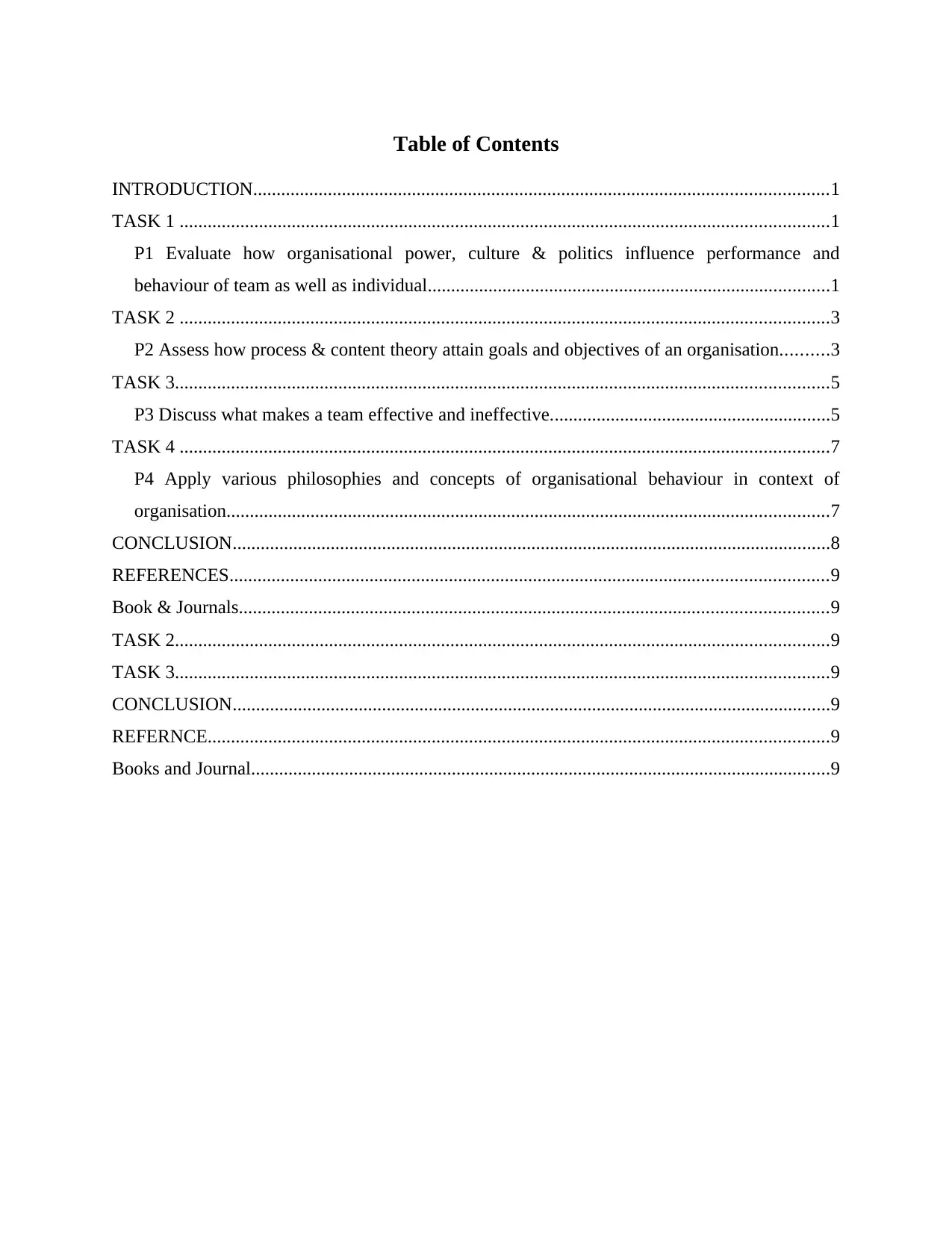
Table of Contents
INTRODUCTION...........................................................................................................................1
TASK 1 ...........................................................................................................................................1
P1 Evaluate how organisational power, culture & politics influence performance and
behaviour of team as well as individual......................................................................................1
TASK 2 ...........................................................................................................................................3
P2 Assess how process & content theory attain goals and objectives of an organisation..........3
TASK 3............................................................................................................................................5
P3 Discuss what makes a team effective and ineffective............................................................5
TASK 4 ...........................................................................................................................................7
P4 Apply various philosophies and concepts of organisational behaviour in context of
organisation.................................................................................................................................7
CONCLUSION................................................................................................................................8
REFERENCES................................................................................................................................9
Book & Journals..............................................................................................................................9
TASK 2............................................................................................................................................9
TASK 3............................................................................................................................................9
CONCLUSION................................................................................................................................9
REFERNCE.....................................................................................................................................9
Books and Journal............................................................................................................................9
INTRODUCTION...........................................................................................................................1
TASK 1 ...........................................................................................................................................1
P1 Evaluate how organisational power, culture & politics influence performance and
behaviour of team as well as individual......................................................................................1
TASK 2 ...........................................................................................................................................3
P2 Assess how process & content theory attain goals and objectives of an organisation..........3
TASK 3............................................................................................................................................5
P3 Discuss what makes a team effective and ineffective............................................................5
TASK 4 ...........................................................................................................................................7
P4 Apply various philosophies and concepts of organisational behaviour in context of
organisation.................................................................................................................................7
CONCLUSION................................................................................................................................8
REFERENCES................................................................................................................................9
Book & Journals..............................................................................................................................9
TASK 2............................................................................................................................................9
TASK 3............................................................................................................................................9
CONCLUSION................................................................................................................................9
REFERNCE.....................................................................................................................................9
Books and Journal............................................................................................................................9
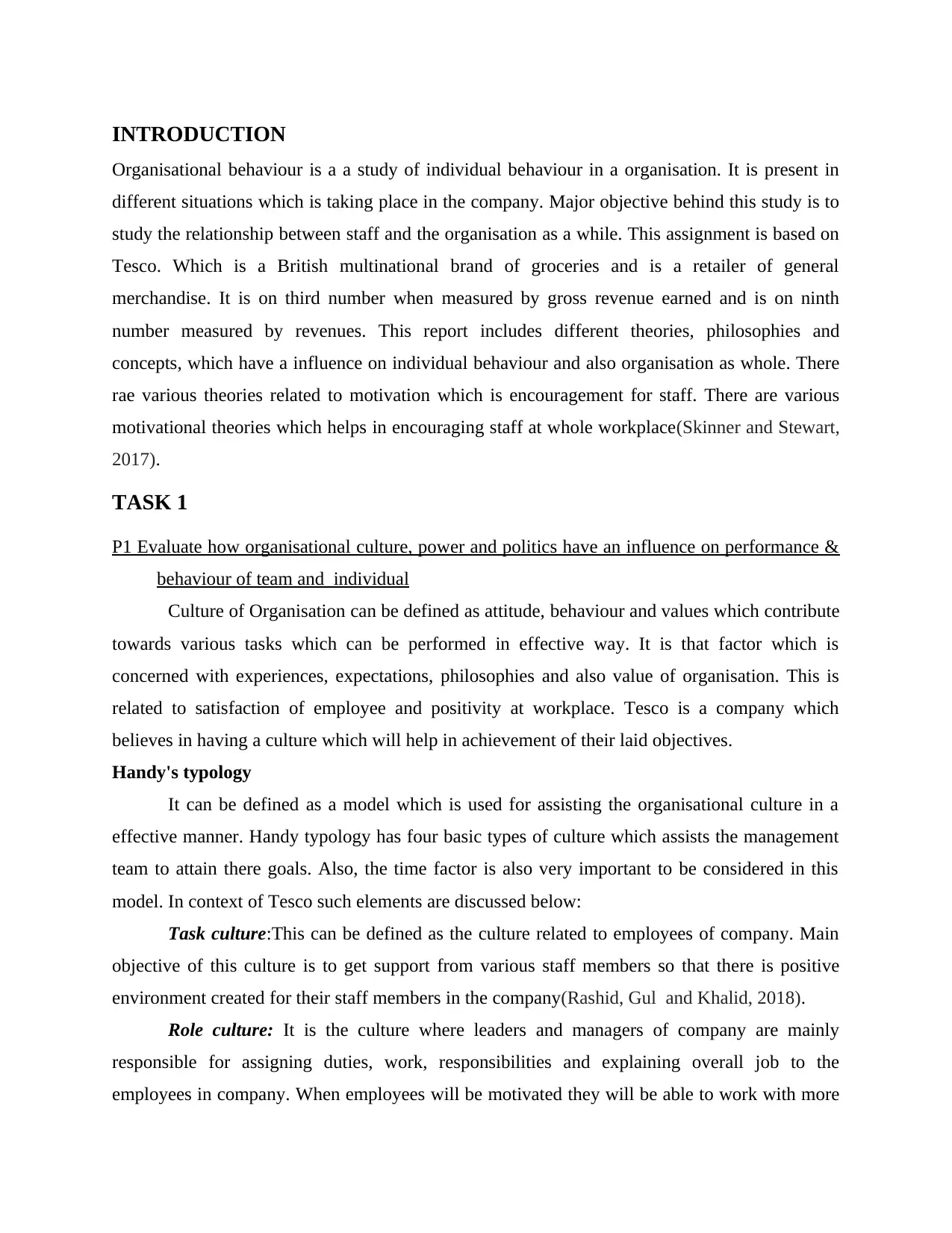
INTRODUCTION
Organisational behaviour is a a study of individual behaviour in a organisation. It is present in
different situations which is taking place in the company. Major objective behind this study is to
study the relationship between staff and the organisation as a while. This assignment is based on
Tesco. Which is a British multinational brand of groceries and is a retailer of general
merchandise. It is on third number when measured by gross revenue earned and is on ninth
number measured by revenues. This report includes different theories, philosophies and
concepts, which have a influence on individual behaviour and also organisation as whole. There
rae various theories related to motivation which is encouragement for staff. There are various
motivational theories which helps in encouraging staff at whole workplace(Skinner and Stewart,
2017).
TASK 1
P1 Evaluate how organisational culture, power and politics have an influence on performance &
behaviour of team and individual
Culture of Organisation can be defined as attitude, behaviour and values which contribute
towards various tasks which can be performed in effective way. It is that factor which is
concerned with experiences, expectations, philosophies and also value of organisation. This is
related to satisfaction of employee and positivity at workplace. Tesco is a company which
believes in having a culture which will help in achievement of their laid objectives.
Handy's typology
It can be defined as a model which is used for assisting the organisational culture in a
effective manner. Handy typology has four basic types of culture which assists the management
team to attain there goals. Also, the time factor is also very important to be considered in this
model. In context of Tesco such elements are discussed below:
Task culture:This can be defined as the culture related to employees of company. Main
objective of this culture is to get support from various staff members so that there is positive
environment created for their staff members in the company(Rashid, Gul and Khalid, 2018).
Role culture: It is the culture where leaders and managers of company are mainly
responsible for assigning duties, work, responsibilities and explaining overall job to the
employees in company. When employees will be motivated they will be able to work with more
Organisational behaviour is a a study of individual behaviour in a organisation. It is present in
different situations which is taking place in the company. Major objective behind this study is to
study the relationship between staff and the organisation as a while. This assignment is based on
Tesco. Which is a British multinational brand of groceries and is a retailer of general
merchandise. It is on third number when measured by gross revenue earned and is on ninth
number measured by revenues. This report includes different theories, philosophies and
concepts, which have a influence on individual behaviour and also organisation as whole. There
rae various theories related to motivation which is encouragement for staff. There are various
motivational theories which helps in encouraging staff at whole workplace(Skinner and Stewart,
2017).
TASK 1
P1 Evaluate how organisational culture, power and politics have an influence on performance &
behaviour of team and individual
Culture of Organisation can be defined as attitude, behaviour and values which contribute
towards various tasks which can be performed in effective way. It is that factor which is
concerned with experiences, expectations, philosophies and also value of organisation. This is
related to satisfaction of employee and positivity at workplace. Tesco is a company which
believes in having a culture which will help in achievement of their laid objectives.
Handy's typology
It can be defined as a model which is used for assisting the organisational culture in a
effective manner. Handy typology has four basic types of culture which assists the management
team to attain there goals. Also, the time factor is also very important to be considered in this
model. In context of Tesco such elements are discussed below:
Task culture:This can be defined as the culture related to employees of company. Main
objective of this culture is to get support from various staff members so that there is positive
environment created for their staff members in the company(Rashid, Gul and Khalid, 2018).
Role culture: It is the culture where leaders and managers of company are mainly
responsible for assigning duties, work, responsibilities and explaining overall job to the
employees in company. When employees will be motivated they will be able to work with more
⊘ This is a preview!⊘
Do you want full access?
Subscribe today to unlock all pages.

Trusted by 1+ million students worldwide
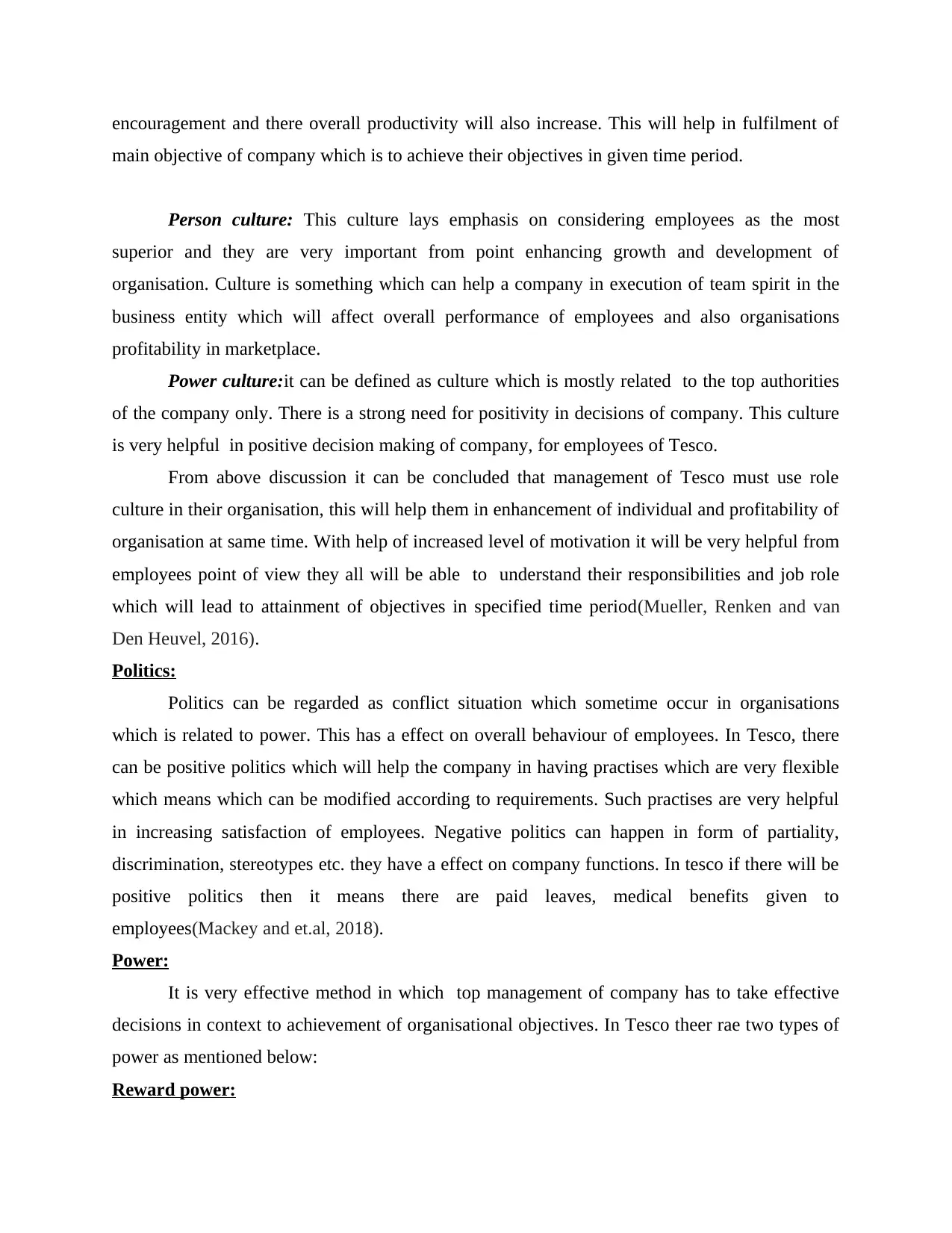
encouragement and there overall productivity will also increase. This will help in fulfilment of
main objective of company which is to achieve their objectives in given time period.
Person culture: This culture lays emphasis on considering employees as the most
superior and they are very important from point enhancing growth and development of
organisation. Culture is something which can help a company in execution of team spirit in the
business entity which will affect overall performance of employees and also organisations
profitability in marketplace.
Power culture:it can be defined as culture which is mostly related to the top authorities
of the company only. There is a strong need for positivity in decisions of company. This culture
is very helpful in positive decision making of company, for employees of Tesco.
From above discussion it can be concluded that management of Tesco must use role
culture in their organisation, this will help them in enhancement of individual and profitability of
organisation at same time. With help of increased level of motivation it will be very helpful from
employees point of view they all will be able to understand their responsibilities and job role
which will lead to attainment of objectives in specified time period(Mueller, Renken and van
Den Heuvel, 2016).
Politics:
Politics can be regarded as conflict situation which sometime occur in organisations
which is related to power. This has a effect on overall behaviour of employees. In Tesco, there
can be positive politics which will help the company in having practises which are very flexible
which means which can be modified according to requirements. Such practises are very helpful
in increasing satisfaction of employees. Negative politics can happen in form of partiality,
discrimination, stereotypes etc. they have a effect on company functions. In tesco if there will be
positive politics then it means there are paid leaves, medical benefits given to
employees(Mackey and et.al, 2018).
Power:
It is very effective method in which top management of company has to take effective
decisions in context to achievement of organisational objectives. In Tesco theer rae two types of
power as mentioned below:
Reward power:
main objective of company which is to achieve their objectives in given time period.
Person culture: This culture lays emphasis on considering employees as the most
superior and they are very important from point enhancing growth and development of
organisation. Culture is something which can help a company in execution of team spirit in the
business entity which will affect overall performance of employees and also organisations
profitability in marketplace.
Power culture:it can be defined as culture which is mostly related to the top authorities
of the company only. There is a strong need for positivity in decisions of company. This culture
is very helpful in positive decision making of company, for employees of Tesco.
From above discussion it can be concluded that management of Tesco must use role
culture in their organisation, this will help them in enhancement of individual and profitability of
organisation at same time. With help of increased level of motivation it will be very helpful from
employees point of view they all will be able to understand their responsibilities and job role
which will lead to attainment of objectives in specified time period(Mueller, Renken and van
Den Heuvel, 2016).
Politics:
Politics can be regarded as conflict situation which sometime occur in organisations
which is related to power. This has a effect on overall behaviour of employees. In Tesco, there
can be positive politics which will help the company in having practises which are very flexible
which means which can be modified according to requirements. Such practises are very helpful
in increasing satisfaction of employees. Negative politics can happen in form of partiality,
discrimination, stereotypes etc. they have a effect on company functions. In tesco if there will be
positive politics then it means there are paid leaves, medical benefits given to
employees(Mackey and et.al, 2018).
Power:
It is very effective method in which top management of company has to take effective
decisions in context to achievement of organisational objectives. In Tesco theer rae two types of
power as mentioned below:
Reward power:
Paraphrase This Document
Need a fresh take? Get an instant paraphrase of this document with our AI Paraphraser
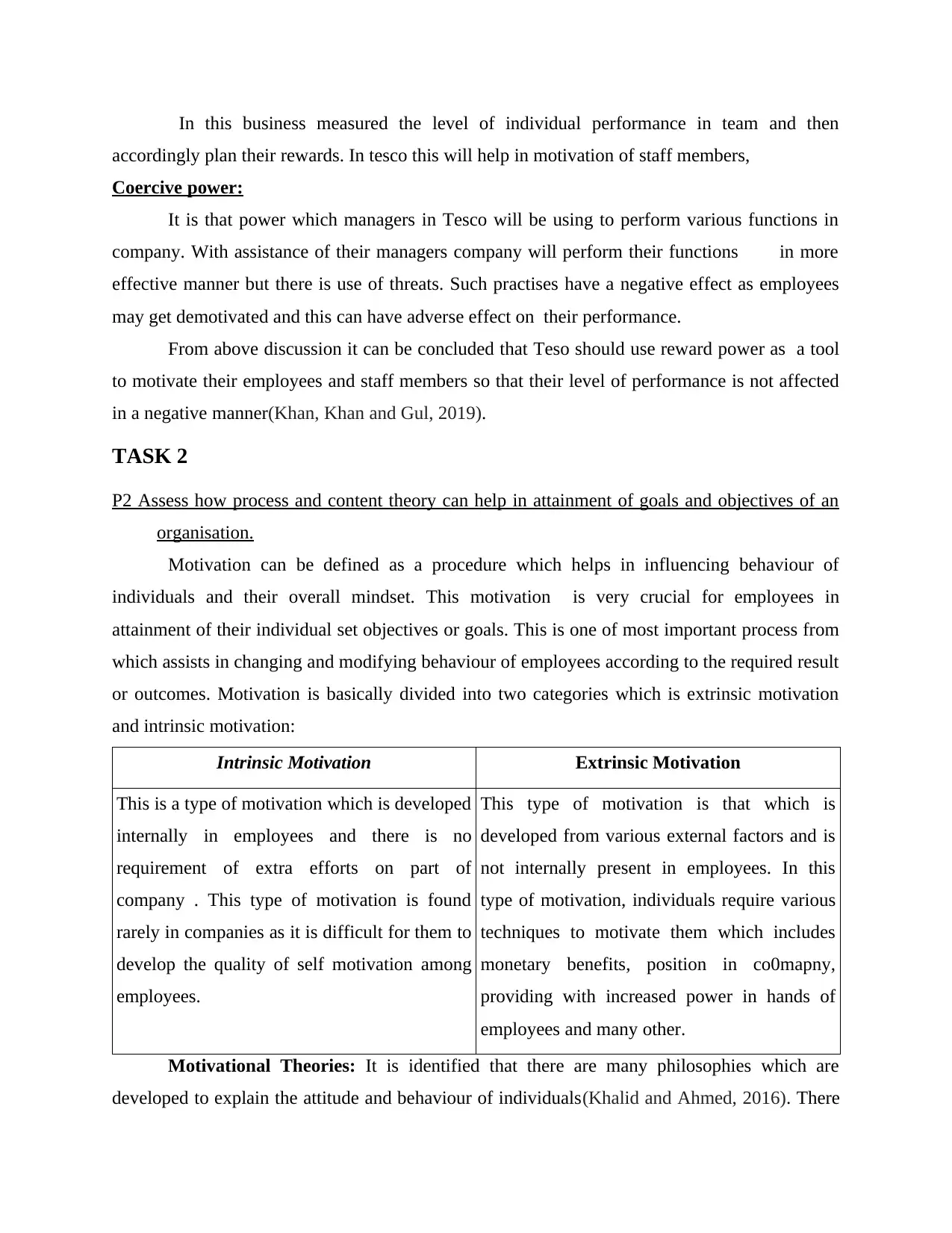
In this business measured the level of individual performance in team and then
accordingly plan their rewards. In tesco this will help in motivation of staff members,
Coercive power:
It is that power which managers in Tesco will be using to perform various functions in
company. With assistance of their managers company will perform their functions in more
effective manner but there is use of threats. Such practises have a negative effect as employees
may get demotivated and this can have adverse effect on their performance.
From above discussion it can be concluded that Teso should use reward power as a tool
to motivate their employees and staff members so that their level of performance is not affected
in a negative manner(Khan, Khan and Gul, 2019).
TASK 2
P2 Assess how process and content theory can help in attainment of goals and objectives of an
organisation.
Motivation can be defined as a procedure which helps in influencing behaviour of
individuals and their overall mindset. This motivation is very crucial for employees in
attainment of their individual set objectives or goals. This is one of most important process from
which assists in changing and modifying behaviour of employees according to the required result
or outcomes. Motivation is basically divided into two categories which is extrinsic motivation
and intrinsic motivation:
Intrinsic Motivation Extrinsic Motivation
This is a type of motivation which is developed
internally in employees and there is no
requirement of extra efforts on part of
company . This type of motivation is found
rarely in companies as it is difficult for them to
develop the quality of self motivation among
employees.
This type of motivation is that which is
developed from various external factors and is
not internally present in employees. In this
type of motivation, individuals require various
techniques to motivate them which includes
monetary benefits, position in co0mapny,
providing with increased power in hands of
employees and many other.
Motivational Theories: It is identified that there are many philosophies which are
developed to explain the attitude and behaviour of individuals(Khalid and Ahmed, 2016). There
accordingly plan their rewards. In tesco this will help in motivation of staff members,
Coercive power:
It is that power which managers in Tesco will be using to perform various functions in
company. With assistance of their managers company will perform their functions in more
effective manner but there is use of threats. Such practises have a negative effect as employees
may get demotivated and this can have adverse effect on their performance.
From above discussion it can be concluded that Teso should use reward power as a tool
to motivate their employees and staff members so that their level of performance is not affected
in a negative manner(Khan, Khan and Gul, 2019).
TASK 2
P2 Assess how process and content theory can help in attainment of goals and objectives of an
organisation.
Motivation can be defined as a procedure which helps in influencing behaviour of
individuals and their overall mindset. This motivation is very crucial for employees in
attainment of their individual set objectives or goals. This is one of most important process from
which assists in changing and modifying behaviour of employees according to the required result
or outcomes. Motivation is basically divided into two categories which is extrinsic motivation
and intrinsic motivation:
Intrinsic Motivation Extrinsic Motivation
This is a type of motivation which is developed
internally in employees and there is no
requirement of extra efforts on part of
company . This type of motivation is found
rarely in companies as it is difficult for them to
develop the quality of self motivation among
employees.
This type of motivation is that which is
developed from various external factors and is
not internally present in employees. In this
type of motivation, individuals require various
techniques to motivate them which includes
monetary benefits, position in co0mapny,
providing with increased power in hands of
employees and many other.
Motivational Theories: It is identified that there are many philosophies which are
developed to explain the attitude and behaviour of individuals(Khalid and Ahmed, 2016). There
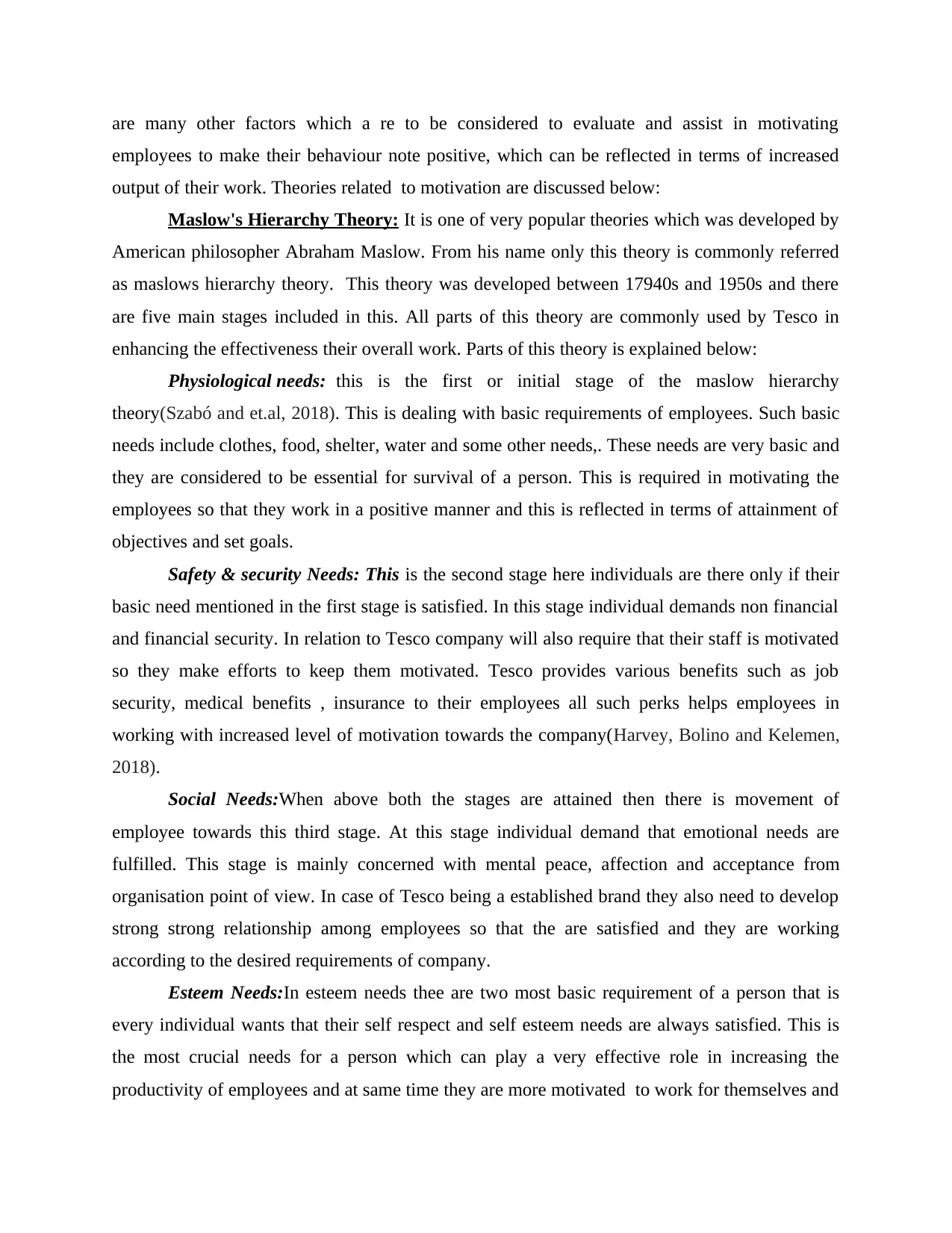
are many other factors which a re to be considered to evaluate and assist in motivating
employees to make their behaviour note positive, which can be reflected in terms of increased
output of their work. Theories related to motivation are discussed below:
Maslow's Hierarchy Theory: It is one of very popular theories which was developed by
American philosopher Abraham Maslow. From his name only this theory is commonly referred
as maslows hierarchy theory. This theory was developed between 17940s and 1950s and there
are five main stages included in this. All parts of this theory are commonly used by Tesco in
enhancing the effectiveness their overall work. Parts of this theory is explained below:
Physiological needs: this is the first or initial stage of the maslow hierarchy
theory(Szabó and et.al, 2018). This is dealing with basic requirements of employees. Such basic
needs include clothes, food, shelter, water and some other needs,. These needs are very basic and
they are considered to be essential for survival of a person. This is required in motivating the
employees so that they work in a positive manner and this is reflected in terms of attainment of
objectives and set goals.
Safety & security Needs: This is the second stage here individuals are there only if their
basic need mentioned in the first stage is satisfied. In this stage individual demands non financial
and financial security. In relation to Tesco company will also require that their staff is motivated
so they make efforts to keep them motivated. Tesco provides various benefits such as job
security, medical benefits , insurance to their employees all such perks helps employees in
working with increased level of motivation towards the company(Harvey, Bolino and Kelemen,
2018).
Social Needs:When above both the stages are attained then there is movement of
employee towards this third stage. At this stage individual demand that emotional needs are
fulfilled. This stage is mainly concerned with mental peace, affection and acceptance from
organisation point of view. In case of Tesco being a established brand they also need to develop
strong strong relationship among employees so that the are satisfied and they are working
according to the desired requirements of company.
Esteem Needs:In esteem needs thee are two most basic requirement of a person that is
every individual wants that their self respect and self esteem needs are always satisfied. This is
the most crucial needs for a person which can play a very effective role in increasing the
productivity of employees and at same time they are more motivated to work for themselves and
employees to make their behaviour note positive, which can be reflected in terms of increased
output of their work. Theories related to motivation are discussed below:
Maslow's Hierarchy Theory: It is one of very popular theories which was developed by
American philosopher Abraham Maslow. From his name only this theory is commonly referred
as maslows hierarchy theory. This theory was developed between 17940s and 1950s and there
are five main stages included in this. All parts of this theory are commonly used by Tesco in
enhancing the effectiveness their overall work. Parts of this theory is explained below:
Physiological needs: this is the first or initial stage of the maslow hierarchy
theory(Szabó and et.al, 2018). This is dealing with basic requirements of employees. Such basic
needs include clothes, food, shelter, water and some other needs,. These needs are very basic and
they are considered to be essential for survival of a person. This is required in motivating the
employees so that they work in a positive manner and this is reflected in terms of attainment of
objectives and set goals.
Safety & security Needs: This is the second stage here individuals are there only if their
basic need mentioned in the first stage is satisfied. In this stage individual demands non financial
and financial security. In relation to Tesco company will also require that their staff is motivated
so they make efforts to keep them motivated. Tesco provides various benefits such as job
security, medical benefits , insurance to their employees all such perks helps employees in
working with increased level of motivation towards the company(Harvey, Bolino and Kelemen,
2018).
Social Needs:When above both the stages are attained then there is movement of
employee towards this third stage. At this stage individual demand that emotional needs are
fulfilled. This stage is mainly concerned with mental peace, affection and acceptance from
organisation point of view. In case of Tesco being a established brand they also need to develop
strong strong relationship among employees so that the are satisfied and they are working
according to the desired requirements of company.
Esteem Needs:In esteem needs thee are two most basic requirement of a person that is
every individual wants that their self respect and self esteem needs are always satisfied. This is
the most crucial needs for a person which can play a very effective role in increasing the
productivity of employees and at same time they are more motivated to work for themselves and
⊘ This is a preview!⊘
Do you want full access?
Subscribe today to unlock all pages.

Trusted by 1+ million students worldwide
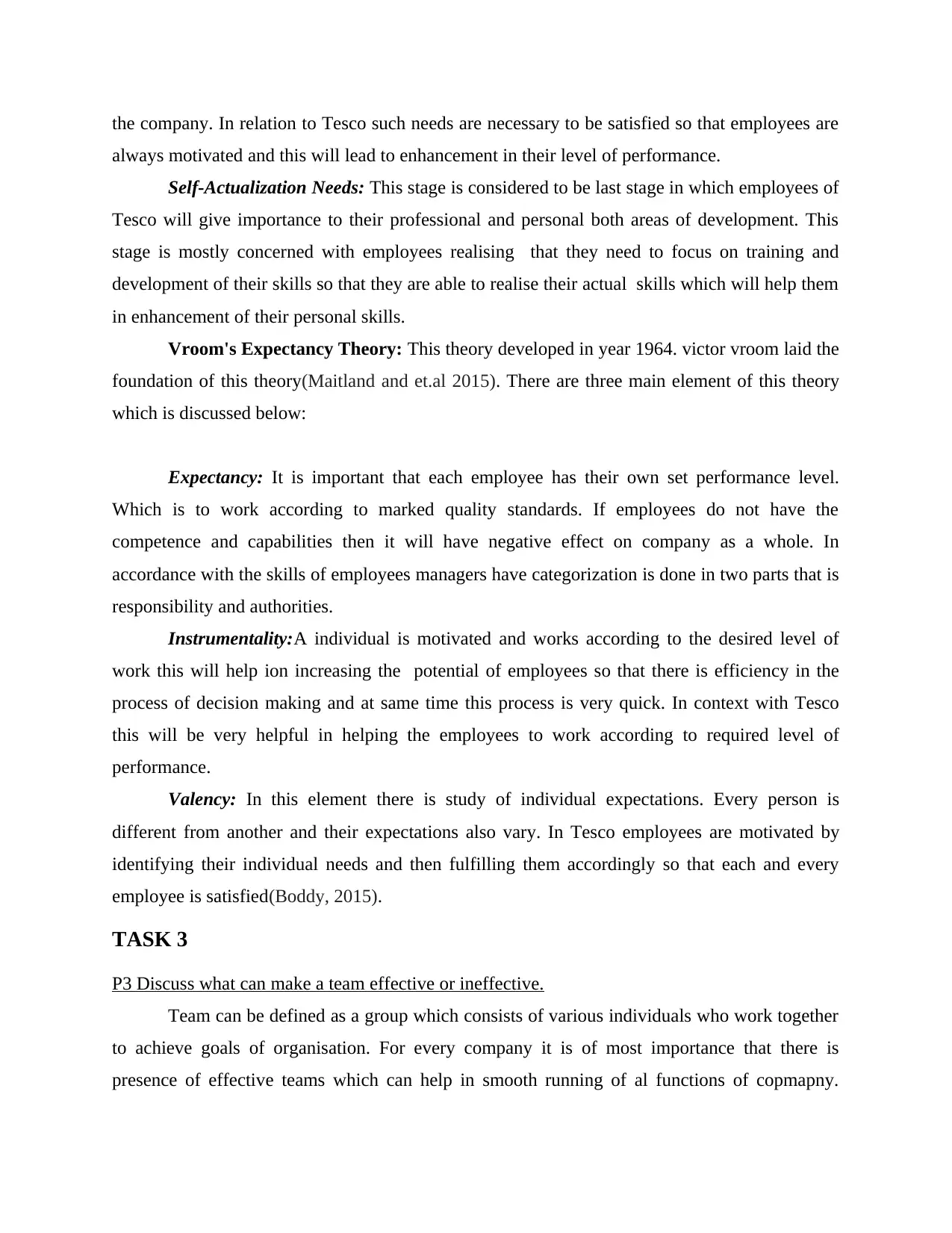
the company. In relation to Tesco such needs are necessary to be satisfied so that employees are
always motivated and this will lead to enhancement in their level of performance.
Self-Actualization Needs: This stage is considered to be last stage in which employees of
Tesco will give importance to their professional and personal both areas of development. This
stage is mostly concerned with employees realising that they need to focus on training and
development of their skills so that they are able to realise their actual skills which will help them
in enhancement of their personal skills.
Vroom's Expectancy Theory: This theory developed in year 1964. victor vroom laid the
foundation of this theory(Maitland and et.al 2015). There are three main element of this theory
which is discussed below:
Expectancy: It is important that each employee has their own set performance level.
Which is to work according to marked quality standards. If employees do not have the
competence and capabilities then it will have negative effect on company as a whole. In
accordance with the skills of employees managers have categorization is done in two parts that is
responsibility and authorities.
Instrumentality:A individual is motivated and works according to the desired level of
work this will help ion increasing the potential of employees so that there is efficiency in the
process of decision making and at same time this process is very quick. In context with Tesco
this will be very helpful in helping the employees to work according to required level of
performance.
Valency: In this element there is study of individual expectations. Every person is
different from another and their expectations also vary. In Tesco employees are motivated by
identifying their individual needs and then fulfilling them accordingly so that each and every
employee is satisfied(Boddy, 2015).
TASK 3
P3 Discuss what can make a team effective or ineffective.
Team can be defined as a group which consists of various individuals who work together
to achieve goals of organisation. For every company it is of most importance that there is
presence of effective teams which can help in smooth running of al functions of copmapny.
always motivated and this will lead to enhancement in their level of performance.
Self-Actualization Needs: This stage is considered to be last stage in which employees of
Tesco will give importance to their professional and personal both areas of development. This
stage is mostly concerned with employees realising that they need to focus on training and
development of their skills so that they are able to realise their actual skills which will help them
in enhancement of their personal skills.
Vroom's Expectancy Theory: This theory developed in year 1964. victor vroom laid the
foundation of this theory(Maitland and et.al 2015). There are three main element of this theory
which is discussed below:
Expectancy: It is important that each employee has their own set performance level.
Which is to work according to marked quality standards. If employees do not have the
competence and capabilities then it will have negative effect on company as a whole. In
accordance with the skills of employees managers have categorization is done in two parts that is
responsibility and authorities.
Instrumentality:A individual is motivated and works according to the desired level of
work this will help ion increasing the potential of employees so that there is efficiency in the
process of decision making and at same time this process is very quick. In context with Tesco
this will be very helpful in helping the employees to work according to required level of
performance.
Valency: In this element there is study of individual expectations. Every person is
different from another and their expectations also vary. In Tesco employees are motivated by
identifying their individual needs and then fulfilling them accordingly so that each and every
employee is satisfied(Boddy, 2015).
TASK 3
P3 Discuss what can make a team effective or ineffective.
Team can be defined as a group which consists of various individuals who work together
to achieve goals of organisation. For every company it is of most importance that there is
presence of effective teams which can help in smooth running of al functions of copmapny.
Paraphrase This Document
Need a fresh take? Get an instant paraphrase of this document with our AI Paraphraser
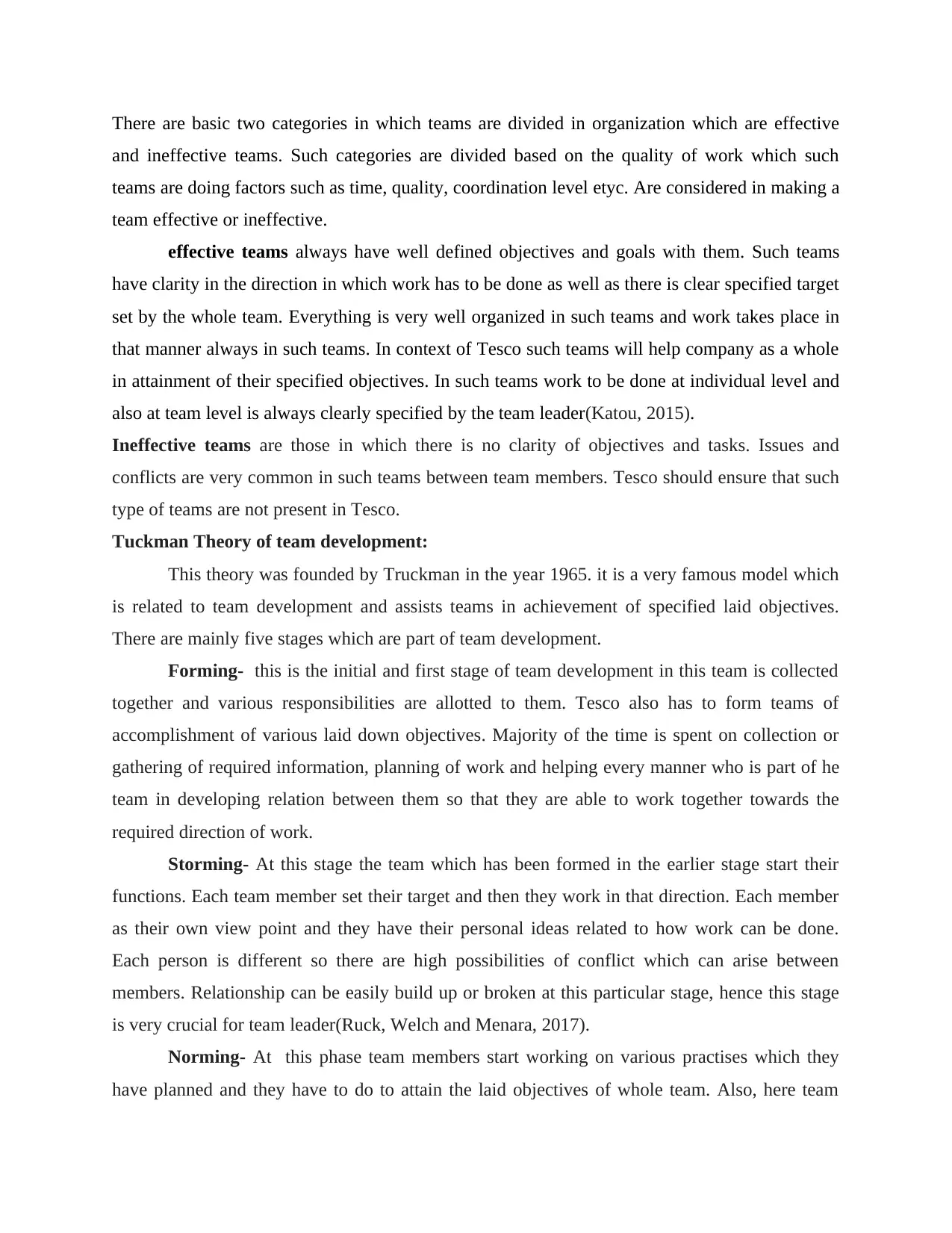
There are basic two categories in which teams are divided in organization which are effective
and ineffective teams. Such categories are divided based on the quality of work which such
teams are doing factors such as time, quality, coordination level etyc. Are considered in making a
team effective or ineffective.
effective teams always have well defined objectives and goals with them. Such teams
have clarity in the direction in which work has to be done as well as there is clear specified target
set by the whole team. Everything is very well organized in such teams and work takes place in
that manner always in such teams. In context of Tesco such teams will help company as a whole
in attainment of their specified objectives. In such teams work to be done at individual level and
also at team level is always clearly specified by the team leader(Katou, 2015).
Ineffective teams are those in which there is no clarity of objectives and tasks. Issues and
conflicts are very common in such teams between team members. Tesco should ensure that such
type of teams are not present in Tesco.
Tuckman Theory of team development:
This theory was founded by Truckman in the year 1965. it is a very famous model which
is related to team development and assists teams in achievement of specified laid objectives.
There are mainly five stages which are part of team development.
Forming- this is the initial and first stage of team development in this team is collected
together and various responsibilities are allotted to them. Tesco also has to form teams of
accomplishment of various laid down objectives. Majority of the time is spent on collection or
gathering of required information, planning of work and helping every manner who is part of he
team in developing relation between them so that they are able to work together towards the
required direction of work.
Storming- At this stage the team which has been formed in the earlier stage start their
functions. Each team member set their target and then they work in that direction. Each member
as their own view point and they have their personal ideas related to how work can be done.
Each person is different so there are high possibilities of conflict which can arise between
members. Relationship can be easily build up or broken at this particular stage, hence this stage
is very crucial for team leader(Ruck, Welch and Menara, 2017).
Norming- At this phase team members start working on various practises which they
have planned and they have to do to attain the laid objectives of whole team. Also, here team
and ineffective teams. Such categories are divided based on the quality of work which such
teams are doing factors such as time, quality, coordination level etyc. Are considered in making a
team effective or ineffective.
effective teams always have well defined objectives and goals with them. Such teams
have clarity in the direction in which work has to be done as well as there is clear specified target
set by the whole team. Everything is very well organized in such teams and work takes place in
that manner always in such teams. In context of Tesco such teams will help company as a whole
in attainment of their specified objectives. In such teams work to be done at individual level and
also at team level is always clearly specified by the team leader(Katou, 2015).
Ineffective teams are those in which there is no clarity of objectives and tasks. Issues and
conflicts are very common in such teams between team members. Tesco should ensure that such
type of teams are not present in Tesco.
Tuckman Theory of team development:
This theory was founded by Truckman in the year 1965. it is a very famous model which
is related to team development and assists teams in achievement of specified laid objectives.
There are mainly five stages which are part of team development.
Forming- this is the initial and first stage of team development in this team is collected
together and various responsibilities are allotted to them. Tesco also has to form teams of
accomplishment of various laid down objectives. Majority of the time is spent on collection or
gathering of required information, planning of work and helping every manner who is part of he
team in developing relation between them so that they are able to work together towards the
required direction of work.
Storming- At this stage the team which has been formed in the earlier stage start their
functions. Each team member set their target and then they work in that direction. Each member
as their own view point and they have their personal ideas related to how work can be done.
Each person is different so there are high possibilities of conflict which can arise between
members. Relationship can be easily build up or broken at this particular stage, hence this stage
is very crucial for team leader(Ruck, Welch and Menara, 2017).
Norming- At this phase team members start working on various practises which they
have planned and they have to do to attain the laid objectives of whole team. Also, here team
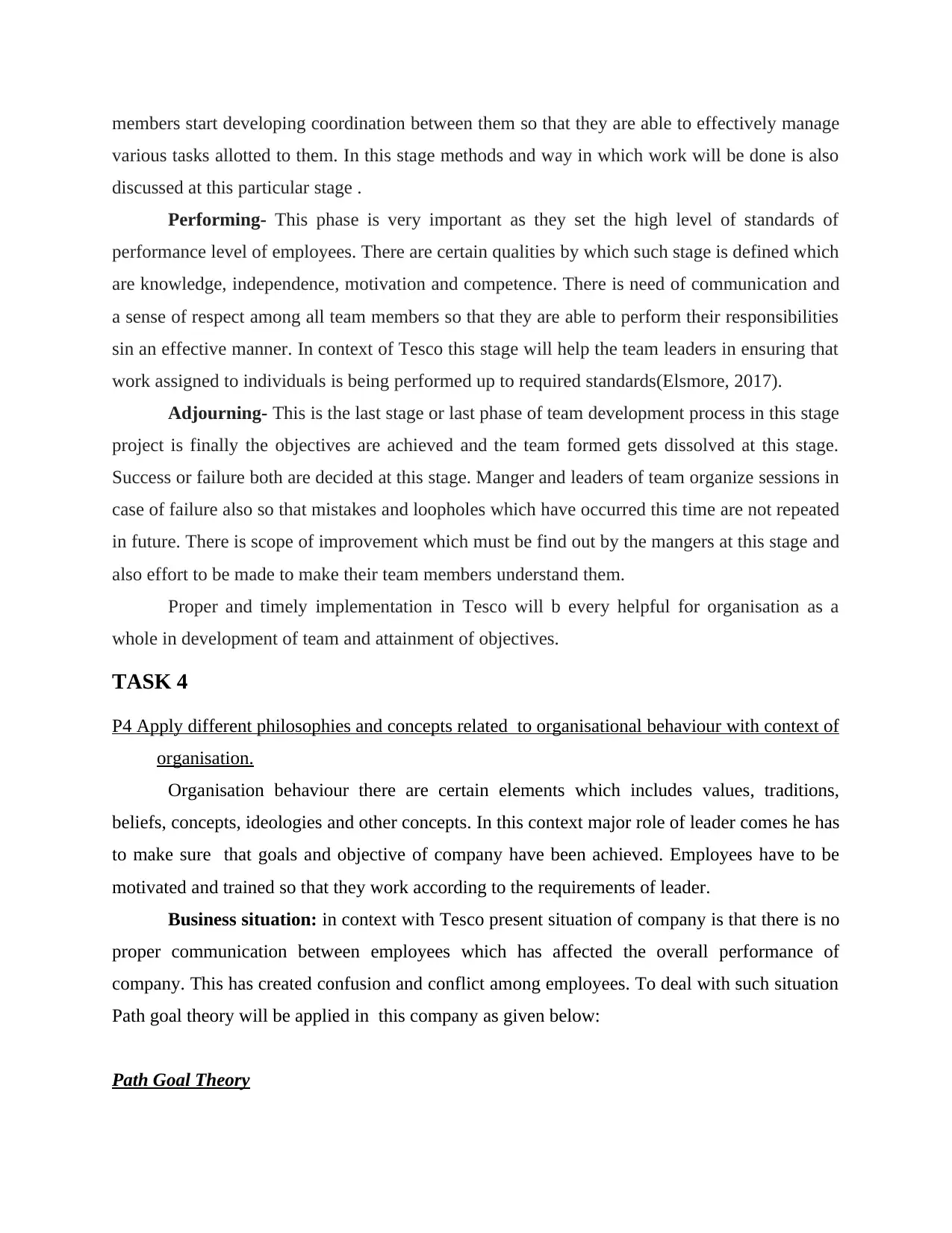
members start developing coordination between them so that they are able to effectively manage
various tasks allotted to them. In this stage methods and way in which work will be done is also
discussed at this particular stage .
Performing- This phase is very important as they set the high level of standards of
performance level of employees. There are certain qualities by which such stage is defined which
are knowledge, independence, motivation and competence. There is need of communication and
a sense of respect among all team members so that they are able to perform their responsibilities
sin an effective manner. In context of Tesco this stage will help the team leaders in ensuring that
work assigned to individuals is being performed up to required standards(Elsmore, 2017).
Adjourning- This is the last stage or last phase of team development process in this stage
project is finally the objectives are achieved and the team formed gets dissolved at this stage.
Success or failure both are decided at this stage. Manger and leaders of team organize sessions in
case of failure also so that mistakes and loopholes which have occurred this time are not repeated
in future. There is scope of improvement which must be find out by the mangers at this stage and
also effort to be made to make their team members understand them.
Proper and timely implementation in Tesco will b every helpful for organisation as a
whole in development of team and attainment of objectives.
TASK 4
P4 Apply different philosophies and concepts related to organisational behaviour with context of
organisation.
Organisation behaviour there are certain elements which includes values, traditions,
beliefs, concepts, ideologies and other concepts. In this context major role of leader comes he has
to make sure that goals and objective of company have been achieved. Employees have to be
motivated and trained so that they work according to the requirements of leader.
Business situation: in context with Tesco present situation of company is that there is no
proper communication between employees which has affected the overall performance of
company. This has created confusion and conflict among employees. To deal with such situation
Path goal theory will be applied in this company as given below:
Path Goal Theory
various tasks allotted to them. In this stage methods and way in which work will be done is also
discussed at this particular stage .
Performing- This phase is very important as they set the high level of standards of
performance level of employees. There are certain qualities by which such stage is defined which
are knowledge, independence, motivation and competence. There is need of communication and
a sense of respect among all team members so that they are able to perform their responsibilities
sin an effective manner. In context of Tesco this stage will help the team leaders in ensuring that
work assigned to individuals is being performed up to required standards(Elsmore, 2017).
Adjourning- This is the last stage or last phase of team development process in this stage
project is finally the objectives are achieved and the team formed gets dissolved at this stage.
Success or failure both are decided at this stage. Manger and leaders of team organize sessions in
case of failure also so that mistakes and loopholes which have occurred this time are not repeated
in future. There is scope of improvement which must be find out by the mangers at this stage and
also effort to be made to make their team members understand them.
Proper and timely implementation in Tesco will b every helpful for organisation as a
whole in development of team and attainment of objectives.
TASK 4
P4 Apply different philosophies and concepts related to organisational behaviour with context of
organisation.
Organisation behaviour there are certain elements which includes values, traditions,
beliefs, concepts, ideologies and other concepts. In this context major role of leader comes he has
to make sure that goals and objective of company have been achieved. Employees have to be
motivated and trained so that they work according to the requirements of leader.
Business situation: in context with Tesco present situation of company is that there is no
proper communication between employees which has affected the overall performance of
company. This has created confusion and conflict among employees. To deal with such situation
Path goal theory will be applied in this company as given below:
Path Goal Theory
⊘ This is a preview!⊘
Do you want full access?
Subscribe today to unlock all pages.

Trusted by 1+ million students worldwide
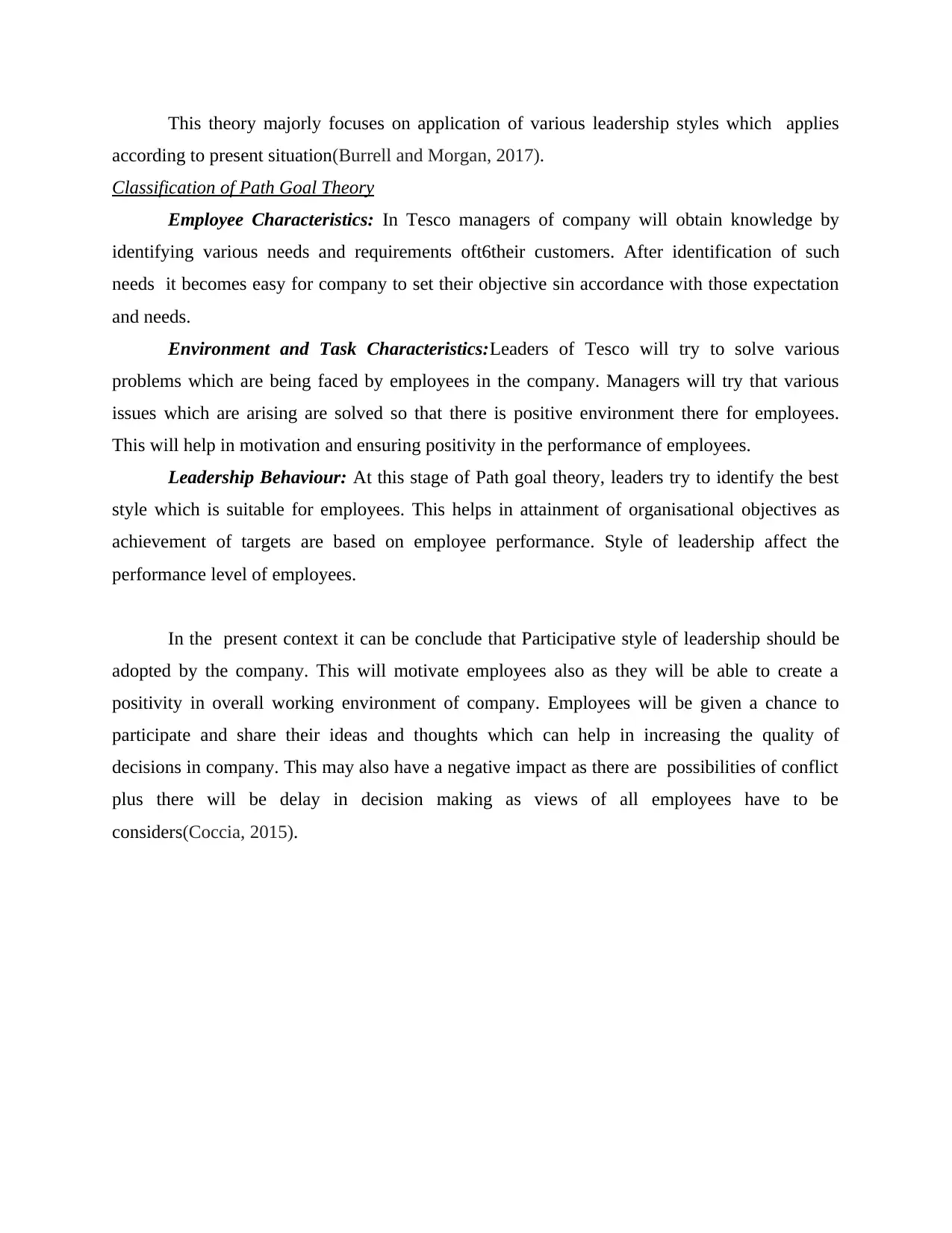
This theory majorly focuses on application of various leadership styles which applies
according to present situation(Burrell and Morgan, 2017).
Classification of Path Goal Theory
Employee Characteristics: In Tesco managers of company will obtain knowledge by
identifying various needs and requirements oft6their customers. After identification of such
needs it becomes easy for company to set their objective sin accordance with those expectation
and needs.
Environment and Task Characteristics:Leaders of Tesco will try to solve various
problems which are being faced by employees in the company. Managers will try that various
issues which are arising are solved so that there is positive environment there for employees.
This will help in motivation and ensuring positivity in the performance of employees.
Leadership Behaviour: At this stage of Path goal theory, leaders try to identify the best
style which is suitable for employees. This helps in attainment of organisational objectives as
achievement of targets are based on employee performance. Style of leadership affect the
performance level of employees.
In the present context it can be conclude that Participative style of leadership should be
adopted by the company. This will motivate employees also as they will be able to create a
positivity in overall working environment of company. Employees will be given a chance to
participate and share their ideas and thoughts which can help in increasing the quality of
decisions in company. This may also have a negative impact as there are possibilities of conflict
plus there will be delay in decision making as views of all employees have to be
considers(Coccia, 2015).
according to present situation(Burrell and Morgan, 2017).
Classification of Path Goal Theory
Employee Characteristics: In Tesco managers of company will obtain knowledge by
identifying various needs and requirements oft6their customers. After identification of such
needs it becomes easy for company to set their objective sin accordance with those expectation
and needs.
Environment and Task Characteristics:Leaders of Tesco will try to solve various
problems which are being faced by employees in the company. Managers will try that various
issues which are arising are solved so that there is positive environment there for employees.
This will help in motivation and ensuring positivity in the performance of employees.
Leadership Behaviour: At this stage of Path goal theory, leaders try to identify the best
style which is suitable for employees. This helps in attainment of organisational objectives as
achievement of targets are based on employee performance. Style of leadership affect the
performance level of employees.
In the present context it can be conclude that Participative style of leadership should be
adopted by the company. This will motivate employees also as they will be able to create a
positivity in overall working environment of company. Employees will be given a chance to
participate and share their ideas and thoughts which can help in increasing the quality of
decisions in company. This may also have a negative impact as there are possibilities of conflict
plus there will be delay in decision making as views of all employees have to be
considers(Coccia, 2015).
Paraphrase This Document
Need a fresh take? Get an instant paraphrase of this document with our AI Paraphraser
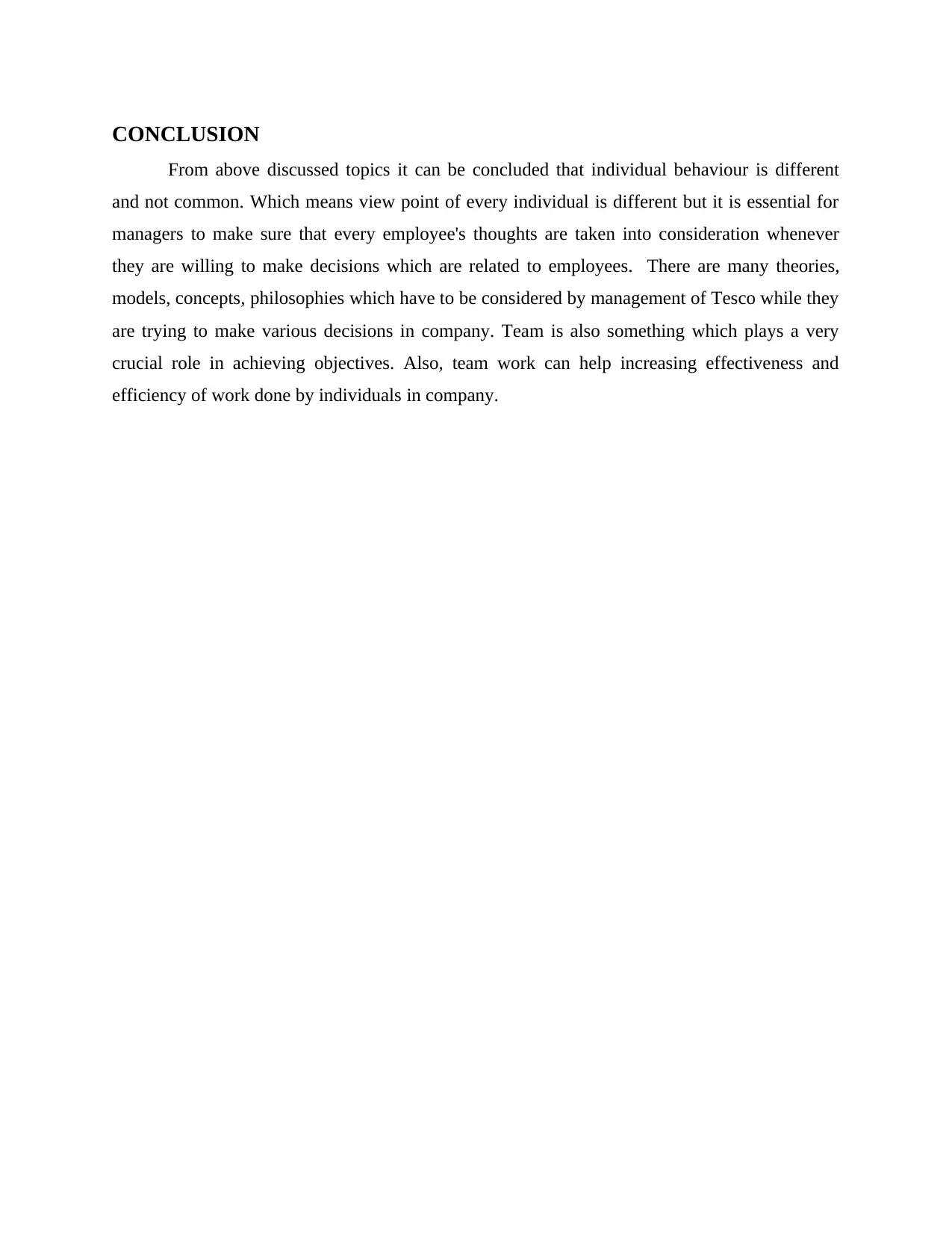
CONCLUSION
From above discussed topics it can be concluded that individual behaviour is different
and not common. Which means view point of every individual is different but it is essential for
managers to make sure that every employee's thoughts are taken into consideration whenever
they are willing to make decisions which are related to employees. There are many theories,
models, concepts, philosophies which have to be considered by management of Tesco while they
are trying to make various decisions in company. Team is also something which plays a very
crucial role in achieving objectives. Also, team work can help increasing effectiveness and
efficiency of work done by individuals in company.
From above discussed topics it can be concluded that individual behaviour is different
and not common. Which means view point of every individual is different but it is essential for
managers to make sure that every employee's thoughts are taken into consideration whenever
they are willing to make decisions which are related to employees. There are many theories,
models, concepts, philosophies which have to be considered by management of Tesco while they
are trying to make various decisions in company. Team is also something which plays a very
crucial role in achieving objectives. Also, team work can help increasing effectiveness and
efficiency of work done by individuals in company.

REFERENCES
Book & Journals
Coccia, M., 2015. Structure and organisational behaviour of public research institutions under
unstable growth of human resources. Coccia, M.(2014)‘Structure and organisational
behaviour of public research institutions under unstable growth of human resources’,
Int. J. Services Technology and Management, 20(4/5), p.6.
Burrell, G. and Morgan, G., 2017. Sociological paradigms and organisational analysis: Elements
of the sociology of corporate life. Routledge.
Elsmore, P., 2017. Organisational Culture: Organisational Change?: Organisational Change?.
Routledge.
Ruck, K., Welch, M. and Menara, B., 2017. Employee voice: An antecedent to organisational
engagement?. Public Relations Review, 43(5), pp.904-914.
Katou, A.A., 2015. Transformational leadership and organisational performance: Three serially
mediating mechanisms. Employee Relations, 37(3), pp.329-353.
Boddy, C.R., 2015. Organisational psychopaths: a ten year update. Management
Decision, 53(10), pp.2407-2432.
Maitland, A., Hills, L.A. and Rhind, D.J., 2015. Organisational culture in sport–A systematic
review. Sport Management Review, 18(4), pp.501-516.
Harvey, J., Bolino, M. C. and Kelemen, T. K., 2018. Organizational Citizenship Behavior in the
21st Century: How Might Going the Extra Mile Look Different at the Start of the New
Millennium?. In Research in personnel and human resources management (pp. 51-110).
Emerald Publishing Limited.
Khalid, J. and Ahmed, J., 2016. Perceived organizational politics and employee silence:
supervisor trust as a moderator. Journal of the Asia Pacific Economy. 21(2). pp.174-
195.
Khan, N. A., Khan, A. N. and Gul, S., 2019. Relationship between perception of organizational
politics and organizational citizenship behavior: testing a moderated mediation
model. Asian Business & Management. 18(2). pp.122-141.
Mackey, J. D. and et.al, 2018. Perceived organizational obstruction: A mediator that addresses
source–target misalignment between abusive supervision and OCBs. Journal of
Organizational Behavior. 39(10). pp.1283-1295
Mueller, B., Renken, U. and van Den Heuvel, G., 2016. Get Your Act Together: An Alternative
Approach to Understanding the Impact of Technology on Individual and Organizational
Behavior. ACM SIGMIS Database: the DATABASE for Advances in Information
Systems. 47(4). pp.67-83.
Rashid, A., Gul, F. and Khalid, G. K., 2018. Internal corporate social responsibility and intention
to quit: The mediating role of organizational citizenship behavior. NUML International
Journal of Business & Management. 13(1). pp.79-95.
Skinner, J. and Stewart, B., 2017. Organizational behaviour in sport. Routledge.
Szabó, Z. P. and et.al, 2018. “The Darkest of all” The relationship between the Dark Triad traits
and organizational citizenship behavior. Personality and Individual Differences. 134.
pp.352-356.
Book & Journals
Coccia, M., 2015. Structure and organisational behaviour of public research institutions under
unstable growth of human resources. Coccia, M.(2014)‘Structure and organisational
behaviour of public research institutions under unstable growth of human resources’,
Int. J. Services Technology and Management, 20(4/5), p.6.
Burrell, G. and Morgan, G., 2017. Sociological paradigms and organisational analysis: Elements
of the sociology of corporate life. Routledge.
Elsmore, P., 2017. Organisational Culture: Organisational Change?: Organisational Change?.
Routledge.
Ruck, K., Welch, M. and Menara, B., 2017. Employee voice: An antecedent to organisational
engagement?. Public Relations Review, 43(5), pp.904-914.
Katou, A.A., 2015. Transformational leadership and organisational performance: Three serially
mediating mechanisms. Employee Relations, 37(3), pp.329-353.
Boddy, C.R., 2015. Organisational psychopaths: a ten year update. Management
Decision, 53(10), pp.2407-2432.
Maitland, A., Hills, L.A. and Rhind, D.J., 2015. Organisational culture in sport–A systematic
review. Sport Management Review, 18(4), pp.501-516.
Harvey, J., Bolino, M. C. and Kelemen, T. K., 2018. Organizational Citizenship Behavior in the
21st Century: How Might Going the Extra Mile Look Different at the Start of the New
Millennium?. In Research in personnel and human resources management (pp. 51-110).
Emerald Publishing Limited.
Khalid, J. and Ahmed, J., 2016. Perceived organizational politics and employee silence:
supervisor trust as a moderator. Journal of the Asia Pacific Economy. 21(2). pp.174-
195.
Khan, N. A., Khan, A. N. and Gul, S., 2019. Relationship between perception of organizational
politics and organizational citizenship behavior: testing a moderated mediation
model. Asian Business & Management. 18(2). pp.122-141.
Mackey, J. D. and et.al, 2018. Perceived organizational obstruction: A mediator that addresses
source–target misalignment between abusive supervision and OCBs. Journal of
Organizational Behavior. 39(10). pp.1283-1295
Mueller, B., Renken, U. and van Den Heuvel, G., 2016. Get Your Act Together: An Alternative
Approach to Understanding the Impact of Technology on Individual and Organizational
Behavior. ACM SIGMIS Database: the DATABASE for Advances in Information
Systems. 47(4). pp.67-83.
Rashid, A., Gul, F. and Khalid, G. K., 2018. Internal corporate social responsibility and intention
to quit: The mediating role of organizational citizenship behavior. NUML International
Journal of Business & Management. 13(1). pp.79-95.
Skinner, J. and Stewart, B., 2017. Organizational behaviour in sport. Routledge.
Szabó, Z. P. and et.al, 2018. “The Darkest of all” The relationship between the Dark Triad traits
and organizational citizenship behavior. Personality and Individual Differences. 134.
pp.352-356.
⊘ This is a preview!⊘
Do you want full access?
Subscribe today to unlock all pages.

Trusted by 1+ million students worldwide
1 out of 13
Related Documents
Your All-in-One AI-Powered Toolkit for Academic Success.
+13062052269
info@desklib.com
Available 24*7 on WhatsApp / Email
![[object Object]](/_next/static/media/star-bottom.7253800d.svg)
Unlock your academic potential
Copyright © 2020–2025 A2Z Services. All Rights Reserved. Developed and managed by ZUCOL.





